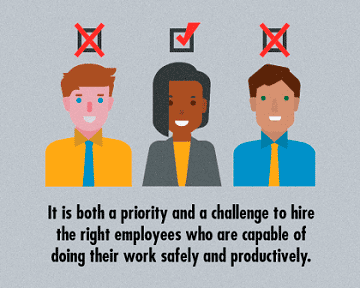- Home
- Loss Control
- Loss Control Insights
- FAQs About Prework Screening!
A properly designed post-offer prework screening program allows employers to determine whether or not their job candidates can perform the essential physical demands of the job. People are often confused by certain aspects of the prework screening process. EMC Industrial Hygienist Krista Scott answers some frequently asked questions she receives from clients about implementing prework screening programs.
What is a prework screening test?
A prework screening test consists of a series of tasks designed to simulate the actual job. It is used to assess a worker’s ability to perform the physical demands of the job they have been hired for.
What is the main reason an employer would want to use prework screening in the workplace?
The primary reason is to hire workers who can physically do the required tasks of the job.
Are there other benefits to using prework screening in the workplace?
Yes. Other benefits to the organization may include:- Demonstrating fair hiring practices
- Reducing the frequency and severity of work-related injuries
- Improving work efficiency by placing the right worker in the right job
- Increasing worker morale through participation in the prework screening process
Are there other uses for the prework screening test in the workplace?
Yes. Using the same criteria developed for the prework screening test, the employer can confirm that an employee returning to work after an injury is fit for work.
Is prework screening legal?
Yes, prework screening is legal when performed according to standards laid out by federal laws, such as the Americans with Disabilities Act, guidelines from the Equal Employment Opportunity Commission and applicable state laws. EMC recommends that you have all prework screening programs reviewed by legal counsel who specializes in employment law prior to implementation.
How are jobs selected to be screened?
Prework screenings are most effective for jobs with the most injuries. Review the physical demands of these jobs and see if there is a way to eliminate or substitute out any injury-causing hazards.
How is a job description developed?
A functional job description is developed by collecting information about the physical demands of the job. This can be done by following EMC’s job description handbook, which walks you through the entire process.
What information will I receive from my physical therapist?
Following each prework screening you should receive pass/fail results. You should also periodically receive information about the number of individuals screened and the total pass/fail rates. Use this information to see if your screening program is working or if there are any particular groups of people that are more likely to fail the test. If this is the case, you may need to see if there any ergonomic modifications or improvements you could make to the job.
If the job candidate has a noticeable condition that could create a risk of injury during the screening, what should be done?
The job candidate should be asked to reschedule his/her testing until they have seen their regular physician about the condition. The testing should not resume until the physician provides written medical clearance to proceed with the prework screening. A time frame should be given to the job candidate within which they must provide the clearance information and reschedule the prework screening. The cost for seeing a physician is the job candidate’s responsibility.
Where should the prework screening take place?
Depending on the type of tests selected, a prework screening may take place at the employer’s place of business, at a therapy/occupational medicine clinic or both.
Where can I find more information about prework screenings?
Visit the prework screening section of EMC’s website for online training, safety program templates, tech sheets, a screening guide and other resources to help you implement an effective prework screening program for your organization.
Get in touch
Need help? We’re here for you! Whether you have questions or need personalized assistance, your local office is ready to support you.
Loss Control Insights
Stay informed with the latest news and receive actionable safety tips, all carefully curated by our team of experts.
